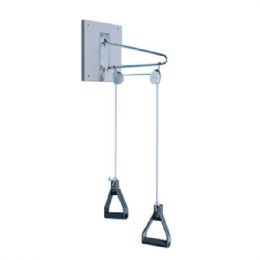







.jpg&newheight=260&quality=80)


What is a Cable Pulley?
A cable pulley is a type of guiding wheel that a woven cable, made of steel or nylon rope, goes around. The pulley wheel has an axle which allows the wheel to spin, and the axle will usually be mounted to a frame that can be attached to a solid object for strength and stability. The wheel may be made of steel or heavy plastic, to prevent premature wear or other damage. To provide a better guiding track for the cable, the pulley wheel is normally grooved or scooped around its perimeter. Common on weight lifting machines are smaller cable pulley systems. Most exercise machines feature only one or two pulleys per cable for a more effective workout.
What is a Pulley Exerciser?
A pulley exerciser is a type of weight training equipment commonly seen in fitness centers and in homes. Some are quite large, but others are built smaller for easy use at home. The exerciser uses one or more cables that run through adjustable pulleys in order to allow for a variety of exercises to be performed. In some pulley exercisers, a metal frame stacks weight plates and the end of the cable is fastened to a metal rod which runs through the center of all the weights. The rod is slotted so a pin can be slipped through the weights, allowing the user to adjust the amount of weight being used. The frame of the pulley exerciser keeps the weights steady to eliminate the possibility of the user losing control of the weights. By adjusting the height of the pulleys, a variety of exercises can be performed that work different parts of the body, including the elbows, arms, shoulders and chest.
What are Range of Motion Exercises?
To help restore and maintain flexibility in the joints, range of motion exercises are specifically designed routines for individuals to use. Exercises of this type are often applied as a means of keeping conditions such as arthritis under control, and as part of rehabilitation after surgery. While most range of motion exercises can be performed without supervision, some are intended to be done under the direction of a helper or physical therapist.
Active range of motion exercises involve the participation of the individual to perform and assess the motion range during each repetition. These exercises are normally used as part of an ongoing maintenance program to strengthen and stabilize the joints. To help restore and maintain flexibility, different range of motion exercises work on each area of the body. Arthritis exercises are ideal for those suffering with stiffness in the wrists, hands and elbows. Other exercises are designed to help individuals recover from surgery; this would include special shoulder exercises for those who have undergone shoulder surgery of any type. Shoulder exercises also help to relax the muscles while making it possible to have a broader range of motion with the arms. Many people with arm and shoulder injuries benefit from pulley exercisers. It can be mounted on a wall or secured to a door, and most utilize weights for adjustable resistance.
With all types of range of motion exercises, it is important to get professional advice before selecting specific routines to perform. A doctor or physical therapist can evaluate the condition of an individual and design a program which will give positive results as well as minimize the chances of causing further damage to the joints. It is not unusual for a professional to supervise the first few sessions to make sure the exercises are done properly. Once a solid concept of how to do each exercise in the sequence and what to look for in the way of joint pain, discomfort, or swelling has been established, the individual can usually do the routine at home. Normally, the regimen is recommended to be done a certain number of times per week instead of traveling to a rehabilitation center for each workout.
Hulet Smith, OT
Rehabmart Co-Founder & CEO
lb